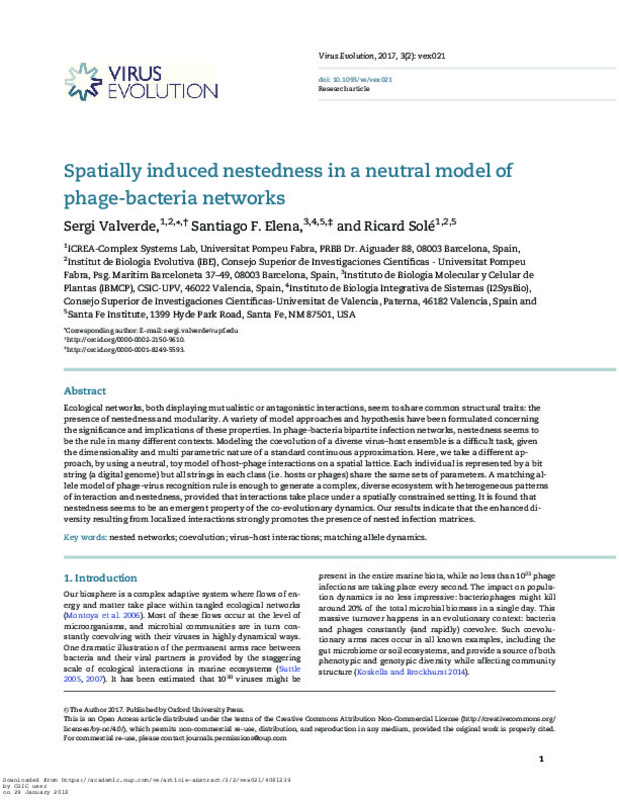Ashby, B., & Boots, M. (2017). Multi-mode fluctuating selection in host-parasite coevolution. Ecology Letters, 20(3), 357-365. doi:10.1111/ele.12734
Atmar, W., & Patterson, B. D. (1993). The measure of order and disorder in the distribution of species in fragmented habitat. Oecologia, 96(3), 373-382. doi:10.1007/bf00317508
Bangham, J., Obbard, D. J., Kim, K.-W., Haddrill, P. R., & Jiggins, F. M. (2007). The age and evolution of an antiviral resistance mutation in
Drosophila melanogaster. Proceedings of the Royal Society B: Biological Sciences, 274(1621), 2027-2034. doi:10.1098/rspb.2007.0611
[+]
Ashby, B., & Boots, M. (2017). Multi-mode fluctuating selection in host-parasite coevolution. Ecology Letters, 20(3), 357-365. doi:10.1111/ele.12734
Atmar, W., & Patterson, B. D. (1993). The measure of order and disorder in the distribution of species in fragmented habitat. Oecologia, 96(3), 373-382. doi:10.1007/bf00317508
Bangham, J., Obbard, D. J., Kim, K.-W., Haddrill, P. R., & Jiggins, F. M. (2007). The age and evolution of an antiviral resistance mutation in
Drosophila melanogaster. Proceedings of the Royal Society B: Biological Sciences, 274(1621), 2027-2034. doi:10.1098/rspb.2007.0611
Bastolla, U., Fortuna, M. A., Pascual-García, A., Ferrera, A., Luque, B., & Bascompte, J. (2009). The architecture of mutualistic networks minimizes competition and increases biodiversity. Nature, 458(7241), 1018-1020. doi:10.1038/nature07950
Beckett, S. J., & Williams, H. T. P. (2013). Coevolutionary diversification creates nested-modular structure in phage–bacteria interaction networks. Interface Focus, 3(6), 20130033. doi:10.1098/rsfs.2013.0033
Bohannan, B. J. M., & Lenski, R. E. (2000). Linking genetic change to community evolution: insights from studies of bacteria and bacteriophage. Ecology Letters, 3(4), 362-377. doi:10.1046/j.1461-0248.2000.00161.x
Flor, H. H. (1956). The Complementary Genic Systems in Flax and Flax Rust. Advances in Genetics, 29-54. doi:10.1016/s0065-2660(08)60498-8
Flores, C. O., Meyer, J. R., Valverde, S., Farr, L., & Weitz, J. S. (2011). Statistical structure of host-phage interactions. Proceedings of the National Academy of Sciences, 108(28), E288-E297. doi:10.1073/pnas.1101595108
Flores, C. O., Valverde, S., & Weitz, J. S. (2012). Multi-scale structure and geographic drivers of cross-infection within marine bacteria and phages. The ISME Journal, 7(3), 520-532. doi:10.1038/ismej.2012.135
Specificity versus detectable polymorphism in host–parasite genetics. (1993). Proceedings of the Royal Society of London. Series B: Biological Sciences, 254(1341), 191-197. doi:10.1098/rspb.1993.0145
Galeano, J., Pastor, J. M., & Iriondo, J. M. (2009). Weighted-Interaction Nestedness Estimator (WINE): A new estimator to calculate over frequency matrices. Environmental Modelling & Software, 24(11), 1342-1346. doi:10.1016/j.envsoft.2009.05.014
Haerter, J. O., Mitarai, N., & Sneppen, K. (2014). Phage and bacteria support mutual diversity in a narrowing staircase of coexistence. The ISME Journal, 8(11), 2317-2326. doi:10.1038/ismej.2014.80
Hillung, J., Cuevas, J. M., Valverde, S., & Elena, S. F. (2014). EXPERIMENTAL EVOLUTION OF AN EMERGING PLANT VIRUS IN HOST GENOTYPES THAT DIFFER IN THEIR SUSCEPTIBILITY TO INFECTION. Evolution, 68(9), 2467-2480. doi:10.1111/evo.12458
Jover, L. F., Cortez, M. H., & Weitz, J. S. (2013). Mechanisms of multi-strain coexistence in host–phage systems with nested infection networks. Journal of Theoretical Biology, 332, 65-77. doi:10.1016/j.jtbi.2013.04.011
Jover, L. F., Flores, C. O., Cortez, M. H., & Weitz, J. S. (2015). Multiple regimes of robust patterns between network structure and biodiversity. Scientific Reports, 5(1). doi:10.1038/srep17856
Korytowski, D. A., & Smith, H. L. (2014). How nested and monogamous infection networks in host-phage communities come to be. Theoretical Ecology, 8(1), 111-120. doi:10.1007/s12080-014-0236-6
Koskella, B., & Brockhurst, M. A. (2014). Bacteria–phage coevolution as a driver of ecological and evolutionary processes in microbial communities. FEMS Microbiology Reviews, 38(5), 916-931. doi:10.1111/1574-6976.12072
MAY, R. M. (1972). Will a Large Complex System be Stable? Nature, 238(5364), 413-414. doi:10.1038/238413a0
Montoya, J. M., Pimm, S. L., & Solé, R. V. (2006). Ecological networks and their fragility. Nature, 442(7100), 259-264. doi:10.1038/nature04927
Mouillot, D., Krasnov, B. R., & Poulin, R. (2008). HIGH INTERVALITY EXPLAINED BY PHYLOGENETIC CONSTRAINTS IN HOST–PARASITE WEBS. Ecology, 89(7), 2043-2051. doi:10.1890/07-1241.1
Poulin, R., & Guégan, J.-F. (2000). Nestedness, anti-nestedness, and the relationship between prevalence and intensity in ectoparasite assemblages of marine fish: a spatial model of species coexistence. International Journal for Parasitology, 30(11), 1147-1152. doi:10.1016/s0020-7519(00)00102-8
Staniczenko, P. P. A., Kopp, J. C., & Allesina, S. (2013). The ghost of nestedness in ecological networks. Nature Communications, 4(1). doi:10.1038/ncomms2422
Suttle, C. A. (2005). Viruses in the sea. Nature, 437(7057), 356-361. doi:10.1038/nature04160
Thompson, J. N., & Burdon, J. J. (1992). Gene-for-gene coevolution between plants and parasites. Nature, 360(6400), 121-125. doi:10.1038/360121a0
VAZQUEZ, D. P., POULIN, R., KRASNOV, B. R., & SHENBROT, G. I. (2005). Species abundance and the distribution of specialization in host-parasite interaction networks. Journal of Animal Ecology, 74(5), 946-955. doi:10.1111/j.1365-2656.2005.00992.x
[-]








